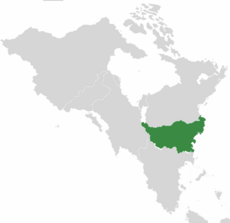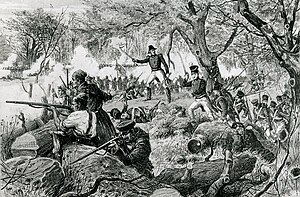User:GristolSerkonos/sandbox3
Federal Republic and Constitutional Union of the Kingdom of Gristol and the Duchy of Serkonos | |
|---|---|
 Political Map | |
 Location of Gristol-Serkonos within the continent of Norumbia in Ajax. | |
| Capital and Largest City | Pontiac-Bernadotte |
| Official languages | Anglic |
| Recognised regional languages | Nordic, Kanienʼkéha, Enyama, Omiat, Hugonaut |
| Ethnic groups (2019) | Keu Kahnawà꞉ke Enyama Mixed |
| Demonym(s) | Gristo-Serkonan |
| Constituent countries |
|
| Government | Federal Parliamentary Presidential Republic |
| Atená:ti Geraldo Pine | |
| Kaniehtí:io Fox | |
| Legislature | Parliament |
| Council of the State | |
| Council of Representatives | |
| Formation | |
• Oath of Union | TBA |
• End of Asherion's Occupation | TBA |
• Pontiac Accords | 1867 |
• Constitution | 1925 |
| Area | |
• Total | 1,386,208 km2 (535,218 sq mi) |
| Population | |
• 2019 estimate | 64,833,770 |
• Density | 46.77/km2 (121.1/sq mi) |
| GDP (nominal) | 2019 estimate |
• Total | NS$1.989 trillion |
• Per capita | 30,678.85 |
| Gini | medium |
| HDI (2019) | very high |
| Currency | Gristo-Serkonan Crown (GSC) |
| Date format | dd-mm-yyyy |
| Driving side | left |
Gristol-Serkonos, officially the Federal Republic and Constitutional Union of the Kingdom of Gristol and the Grand Duchy of Serkonos is a multinational realm comprised of two countries: Gristol and Serkonos. The two countries have devolved administrations, each with varying powers, based in their capitals, Griswald and Donnacona, respectively. The union was a result of the Oath of Union and since then, it has been jointly-ruled by the House Eist of Gristol and the Clan of Konwatsi'tsiaienni of Serkonos until 2022. A reform in the constitution and the federal system resulted in a change from a monarchy to a federal presidential republic. Situated in the continent of Norumbia in the western hemisphere of Ajax, it is bordered by Elatia along its western border and Belfras to the south. Mniohuta and Chenes share the country's northern border. The country's proximity between neighbours has produced a long and complex relationship, with a significant impact on its economy and culture.
The country is home to over 65 million people, with 50% of the population living along the river Lautha which separates the two constituent countries. The city of Pontiac-Bernadotte has been a historic meeting place of the two nations and has since been the United Kingdom's capital. Gristol-Serkonos is an industrialized country, with the xth-highest nominal per-capita income globally as well as the xth-highest ranking in the Human Development Index. It is the xth largest economy, bolstered by its natural resources and well developed trade agreements. Its citizens enjoy high levels of government transparency, civil liberties, quality of life, economic freedom, and education. It is among the most ethnically diverse and multicultural nations, the product of immigration policy encouraged by successive governments.
History
Pre-Unification
Clan Eist originated from the southern coastal territories of modern XXXX. Making landfall on 1150, the clan moved west and extended its domains, bringing petty Hugonaut and the Omiat kingdoms under their control. In 1156, clan leader Griswald Eist styled himself as King and led the formation of the Kingdom of Gristol. Their encounter with minor Runakuna and Kayamuca tribes were initially cordial, eventually leading to their inclusion into the newly forming Kingdom.
O’tara’shón:’a Sha'té:kon, a confederation of Kahnawà꞉ke tribes settle the western banks of the River Lautha. The confederation was known to its southern neighbours as the Atiwandaronk who led the periodic conflicts with the northern territories of the Kayamuca Empire with minor border skirmishes with the Runakunian tribes. Chief Karonghyontye of the Konwatsi'tsiaienni tribe would be elected as the first modern leader of Serkonos. He would led a war to bring a group of petty Haida city-states under its control. The Kahnawà꞉ke would sustain heavy defeats in their first offensive actions against the Haida, but eventually prevail in the four year long conflict.
Encounters with Ottonian, Keu, and Latin cultures influenced the Kahnawà꞉ke in 1163 led to questions on their continued existence as an independent nation when the Kingdom of Gristol begin encroaching on their territory. Faced with a difficult choice, the Kahnawà꞉ke begun to adopt certain western styles, becoming one of the first indigenous nations to westernize. The confederation adopted the Belisarian word Serkonos, as it is phonetically similar to Sha'té:kon.
By 1170, they would encounter each other in the banks of the Lautha river. Initial misunderstandings would lead to periodic border skirmishes that would last 30 years.
Gristo-Serkonan Conflicts
A series of military campaigns were fought between the Serkonan Kahnawà꞉ke and the Kingdom of Gristol in the late 13th and early 14th centuries. The First Gristo-Serkonan War began with the Kingdom of Gristol invading Serkonos in 1266 and ended with the Treaty of Pontiac-Bernadotte in 1367.
The First Gristo-Serkonan War
The Second Gristo-Serkonan War
The eruption of Mount Sirawang in the Ochran region caused a global volcanic winter, sparking the Second Gristo-Serkonan War.
Asherion's Occupation
See also: Verkun Government
Asherion's military campaigns to the northern frontier regions concerned Gristol and Serkonos governments. In response, both governments initiated economic sanctions against Asherion and the Grand Norumbia. Fearing an invasion is imminent, Prince Ulrik Eist met with the five Serkonan tribal chiefs in Donnaconna in 1806. With the support of the Grand Duke Sakayengwaraton of Serkonos, Prince Ulrik Eist formed a Gristo-Serkonan coalition. In 1807, a Gristo-Serkonan army led by Prince Ulrik Eist forced Asherion into a prolonged defensive war in Serkonos. Elements of Gristol's Landforsvaret and Serkonos' Ducal Army engaged Asherion's forces, culminating with the Fire of Donnaconna, in which the Serkonan capital city was nearly completely destroyed. Facing a losing war in the long run, Prince Ulrik Eist was forced to disperse a portion of the army to continue guerilla war against Asherion's troops in occupied Serkonos.
By the summer of 1807, Asherion invaded Gristol, besieging the Free City of Pontiac-Bernadotte.
forcing an evacuation of the Royal Gristol Family, the country's treasury, and key government and military assets in the capital city of Griswald. Prince Eist initiated a scorched earth policy, denying Asherion resources in the Gristol front.
Taking advantages of the dense swamps and marsh regions of Gristol's southern lands, Prince Ulrik Eist formed a defensive front with the remnants of the combined forces around the Audonic and Kamryker-speaking crown-lands of Valois and Jouwer respectively. The Serkonan Ducal Army organized their formations around Jouwer, while Gristol's Landforsvaret units were organized on Valois. Grand Duke Sakayengwaraton, who escaped the Fire of Donnaconna along with the Five Chiefs, arrived a few weeks later with more troops mustered from reserve Ducal Army Legions. A Serkonan Government-in-Exile was established in Verwolde.
Founding of the Union
Present
The election of the new Progressive Conservative government of Kaniehtí:io Fox saw a dramatic change in foreign policy for Gristol-Serkonos. Entering in the Enyaman Civil War and a closer relations with Belfras was one of the major changes introduced by the new government.
On March 2021, a diplomatic row over a crashed experimental Gristo-Serkonan aircraft sparked a naval and air clash between Wazheganon Federal Navy and the Royal Gristo-Serkonan Navy.
Politics
Gristol-Serkonos is described as a "full democracy" with a tradition of liberalism, and an egalitarian, moderate political ideology. Peace, order, and good government, alongside an implied bill of rights are founding principles of the Gristo-Serkonan Federal Government. The country's federal structure divides government responsibilities between the federal government, the two constituent countries, and the fifteen Crown Lands. Legislatures of the Kingdom of Gristol and the Grand Duchy of Serkonos are unicameral and operate in a fashion similar to the federal parliament's Council of Representatives. The Crown Lands also have legislatures, but these are not sovereign and have fewer constitutional responsibilities than the constituent countries.
Executive
Under the revised Constitutional and Federal Reforms of 2022, Gristol-Serkonos elects a President that will serve in the Executive Branch of the Federal Government. This changed from the two monarchs of Gristol and Serkonos who hold mostly ceremonial powers in Parliament. A directly-elected President would share powers with the Chancellor of Gristol-Serkonos, who is elected through the confidence of the Parliament. The President would oversee foreign policy and defense policy while the Chancellor would be in charge of domestic policy and economic policy. The President and Chancellor jointly-head the High Council of Gristol-Serkonos, the body of Ministers that form the Government of Gristol-Serkonos.
The Leaders of the Constituent Countries (The King/Queen of Gristol and the Five Chiefs of Serkonos) also participates in a ceremonial capacity in the political process in the executive branch. Unlike the previous iteration, they will no longer have the executive power to dissolve parliaments, veto legislation, or remove elected officials from power at their own.
Legislative
The Parliament of Gristol-Serkonos is a bicameral legislature. The Parliament consists of the Council of the State and the Council of Representatives. The Council of the State consists of 200 senators with its members elected through proportional representation based on the parties' popular votes. The Council of Representatives consists of 810 Members of Parliament elected through mixed-member proportional representation. 691 Constituency Members of Parliament are elected through a two-round system. 119 Party-List Members of Parliament are elected through proportional representation based on the parties' popular votes.
There are 42 Standing Committees in Gristo-Serkonan Parliament. Each of these standing committees have members from the government and opposition parties. The 23 Standing Committees in the Council of Representatives are responsible for scrutinizing and making recommendations to legislation tabled by the government following first reading. 16 Standing Committees in the Council of the State are responsible for ensuring that the legislation passed by the Council of Representatives are in good standing and are capable of making recommendations in either rejecting or approving legislation. 3 Joint-Standing Committees are comprised of Senators and MPs and is mostly responsible to National Security and Intelligence oversight and Parliamentary and Constitutional Procedures.
Judiciary
Gristol-Serkonos does not have a single legal system. The Federal Supreme Courts is mostly concerned with disputes between Constituent Countries and the legal powers of the two constituent governments or laws made by their legislatures. Gristol Legal System: based on Common Law principles. Serkonan Legal System: a hybrid system of both common and civil law principles.






